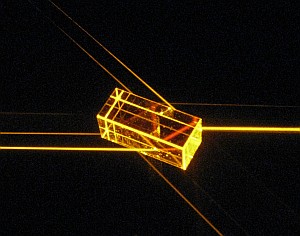|
06 September 2010
Light fulfils a fundamental role in communicating information, from the objects we see to the radio we hear and the data we pass between computers on optical fibers.
Storing light as a form of data, however, has proved to be a difficult task. Scientists have managed to transfer the quantum information of a light field to an atomic gas, but the recall of information has been far below the threshold required for practical application of the technology.
Researchers at the Australian National
University in collaboration with scientists at the University of Otago in New Zealand and
Shanxi University in China 1 have now
developed a solid-state quantum system that offers four times the
recall efficiency of previous systems.
This system (Fig. 1) could store the quantum information of a light pulse and release it on demand with an efficiency of 69% after 1.3 μs.
Fig. 1 A solid-state quantum memory system stores quantum information with efficient retrieval for up to 1.3 μs.
The technique works whether the light field is made up of just a single photon or as many as 500 photons. The researchers observed that only the photons that went into the crystal came out again.
Efficiency of 69% may not seem very high, but storage of a quantum state need not be perfect. Error-correction techniques can salvage a state so long as losses amount to less than 50%.
This is the first time this all-important 50% threshold for quantum memory has been exceeded.
Reference
|

